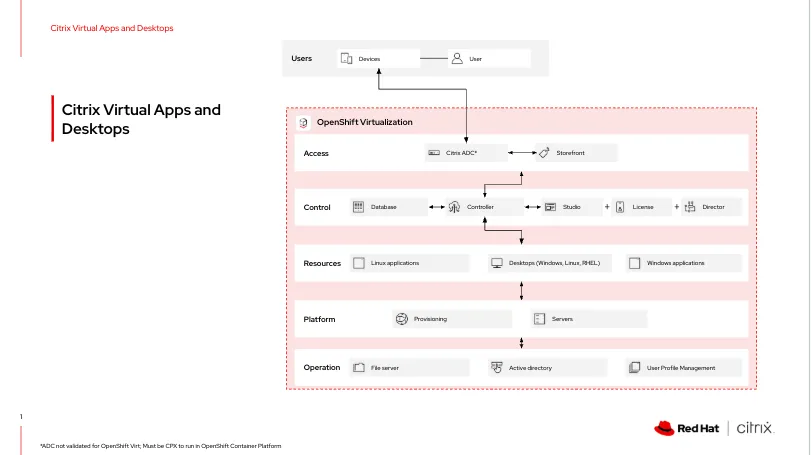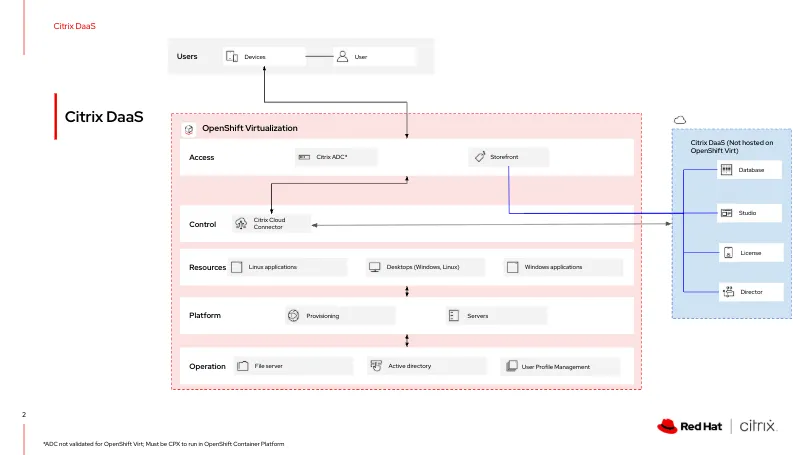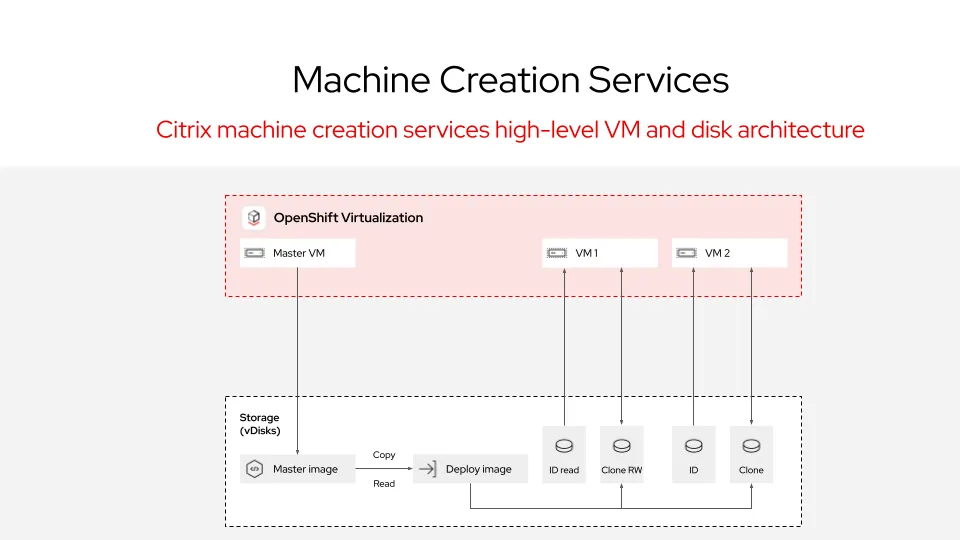Your Citrix Virtual Desktop Infrastructure (VDI) is essential to your infrastructure, but is your underlying platform hindering its potential? Imagine what more could be possible if you ran your mission-critical VDI on a modern virtualization platform built for agility, automation, and choice. Red Hat OpenShift Virtualization, built on the open source KubeVirt project, allows you to migrate and manage VMs on a modern, cloud-native platform.
The new support for Citrix Virtual Apps and Desktops on OpenShift Virtualization allows you to change hypervisors without disrupting Citrix workflows. This isn't about forcing container management, it's about leveraging a powerful, Kubernetes-based platform to run your existing virtual machines with greater efficiency and flexibility.
Think of it as upgrading the engine without changing the car's interior. Your Citrix Virtual Apps and Desktops (CVAD) or Citrix DaaS administrators continue to use their familiar tools, like Citrix Studio and Machine Creation Services (MCS). However, beneath the surface, they gain the power of a platform built for the future.
This integrated platform is also an excellent option if you're currently using a different VDI solution, but you're exploring alternatives for your virtualization stack.
OpenShift Virtualization offers a compelling solution for an organization aiming to modernize its VDI infrastructure, unify traditional and cloud-native workload management, and leverage the benefits of Kubernetes automation and flexibility. Key features include:
- Automated provisioning and scaling: OpenShift enables automated desktop provisioning and dynamic scaling of VDI resources based on demand, potentially eliminating traditional VDI capacity constraints and increasing resource efficiency.
- Robust security: OpenShift incorporates container isolation, network segmentation, and built-in vulnerability scanning to enhance the security posture of Citrix Virtual Apps and Desktops deployments.
- Enhanced performance for specific workloads: For GPU-intensive workloads (including AI, CAD, and medical imaging), OpenShift Virtualization supports efficient GPU sharing through single root I/O virtualization (SR-IOV), potentially leading to significantly faster processing times. Those capabilities are currently under testing, to be made available in a future release of Citrix Virtual Apps and Desktops solution.
The architecture you know, the flexibility you need
OpenShift Virtualization works seamlessly with your Citrix workloads, resulting in a consistent and reliable experience. Citrix infrastructure components, including Delivery Controllers, StoreFront servers, and SQL databases, run as virtual machines inside an OpenShift Virtualization environment. These VMs operate within a Kubernetes-managed cluster, but they behave just like traditional VMs. Citrix admins create an OpenShift connection in Studio and publish machine catalogs backed by these VMs.
Power management (to start, stop, and reboot) happens through familiar Citrix policies. Meanwhile, OpenShift handles orchestration, lifecycle management, and high availability. Existing VM images, from VMware or Hyper-V, can be imported using built-in migration tools. And because the platform is managed as code, repeatable deployments and DevOps integration become easier to achieve.
Reference architecture and workflow for self-managed deployment
This is an illustration of the architecture used for Citrix Virtual Apps and Desktops on OpenShift Virtualization:

Alt text: Example architecture for Citrix Virtual Apps and Desktops on OpenShift Virtualization
Reference architecture and workflow for managed deployment
This is an illustration of architecture for Citrix DaaS on OpenShift Virtualization:

Alt text: Example architecture for Citrix DaaS on Red Hat OpenShift Virtualization
This illustrates the machine creation process:

Alt text: Machine creation on Red Hat OpenShift Virtualization
Access a thriving ecosystem with OpenShift Virtualization
By running Citrix Virtual Apps and Desktops on OpenShift Virtualization, you open the doors to a hub of ecosystem partners connecting you to best-in-class solutions you already use and trust. You have the freedom to choose what works best for your environment with validated solutions from top-tier partners. This ecosystem extends across your entire infrastructure, with an extensive roster of partners for networking, backup and disaster recovery, and compute hardware.
Additionally, the open virtual networking (specifically OVN-Kubernetes) localnet provides a seamless user experience for directly connecting both pods and VMs to your underlying physical network. This enables both internal east-west cluster connectivity and access to services outside the cluster.
Benefits of running Citrix Virtual Apps and Desktops on OpenShift Virtualization
This isn't about lifting and shifting Citrix into containers. It's about future-proofing your virtual machines on an application platform that grows with you without disrupting your current workflows. Here are a few of the primary benefits:
- Proven scalability and performance: OpenShift's architecture scales to thousands of nodes. Our tests successfully scaled to 1,000 VMs, supporting between 10,000 to 20,000 users with shared resources. This is all built on the performance and stability of the Linux Kernel-based Virtual Machine (KVM) hypervisor.
- Seamless migration with a path towards modernization: Import existing VM images from platforms like VMware using built-in migration tools, smoothing your transition to a modern platform. Leverage application modernization processes and development tools to build a cloud-native future.
- Robust and integrated security features: Benefit from OpenShift's built-in security features like role-based access control, SELinux enforcement, and network policies that apply to your virtual machines, providing modern security coverage for your Citrix workloads without custom tooling.
- Easy VM provisioning: Deploy your Windows or Linux desktop with ease using VM templates preloaded in OpenShift. Further streamline this workflow by leveraging the platform's advanced CI/CD capabilities to create customized Windows 11 and 10 golden images.
Unlock a modern infrastructure for your Citrix workloads
The wait is over. Start managing your Citrix Virtual Apps and Desktops workloads on a platform that grows with you without holding you back. Watch the demo to see a real-time demonstration of how Citrix and OpenShift work together, and then review the ecosystem catalog page for more information on how Citrix Virtual Apps and Desktops works on OpenShift Virtualization.
product trial
Red Hat 교육 서브스크립션 | 제품 체험판
저자 소개
A Red Hatter since 2012, Andrea Perotti is a Senior Engineering Partner Manager dedicated to helping software partners seamlessly integrate their solutions with Red Hat’s powerful portfolio. Beyond his work, Andrea is a passionate advocate for the open source community, frequently found at industry events and retrocomputing gatherings, or exploring the Alps.
채널별 검색
오토메이션
기술, 팀, 인프라를 위한 IT 자동화 최신 동향
인공지능
고객이 어디서나 AI 워크로드를 실행할 수 있도록 지원하는 플랫폼 업데이트
오픈 하이브리드 클라우드
하이브리드 클라우드로 더욱 유연한 미래를 구축하는 방법을 알아보세요
보안
환경과 기술 전반에 걸쳐 리스크를 감소하는 방법에 대한 최신 정보
엣지 컴퓨팅
엣지에서의 운영을 단순화하는 플랫폼 업데이트
인프라
세계적으로 인정받은 기업용 Linux 플랫폼에 대한 최신 정보
애플리케이션
복잡한 애플리케이션에 대한 솔루션 더 보기
가상화
온프레미스와 클라우드 환경에서 워크로드를 유연하게 운영하기 위한 엔터프라이즈 가상화의 미래

